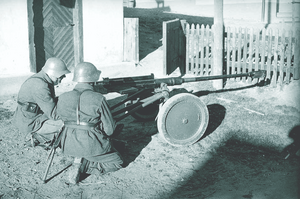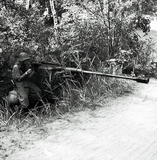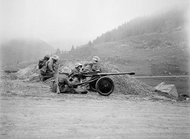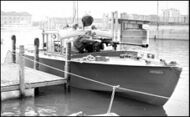FA-36
| Fusil Antichar modele 1936 | |
|---|---|
 FA-36 in a courtyard on YDF exercise, 1938 | |
| Type | Anti-tank weapon |
| Place of origin | |
| Service history | |
| In service | 1936–present[1] |
| Used by | See Users |
| Wars | Second Great War Operation Kipling |
| Production history | |
| Designer | Adolf Meissler |
| Designed | 1935–1936 |
| Manufacturer | Fabrique Nationale Collinebourg Lansing Iron Horse |
| Unit cost | 2,924 Yonderian Argents (1936) |
| Produced | 1936–1946 |
| Specifications | |
| Mass | 74.5 kilograms (164 lb) |
| Length | 2.6 m (8 ft 6 in) |
| Barrel length | overall:1.51 m (4 ft 11 in) (with muzzle brake) |
| Shell | 24×139mm R |
| Caliber | 24 millimetres (0.94 in) |
| Breech | Horizontal sliding block |
| Recoil | Short recoil toggle lock |
| Carriage | Split trail |
| Muzzle velocity | 900 metres per second (3,000 ft/s) |
| Effective firing range | 600 metres (660 yd) (original production) 1,050 metres (1,150 yd) (refurbished) |
| Maximum firing range | 3,500 metres (3,800 yd) |
| Feed system | Six or ten round box magazines Twenty round drum magazine |
| Sights | 2.7x optic Iron sights |
The Fusil Antichar modele 1936, Burgoignesc for "Anti-Tank Rifle model of 1936", abbreviated as FA-36, is a Yonderian heavy anti-tank rifle and super heavy anti-materiel rifle developed during the Second Great War which is still nominally in service with the Yonderian Defence Force's special operations force DELTA.[2] It is also used by the militaries of Tapakdore and Kandara. The FA-36 was adopted by the Yonderian Defence Force in 1936 and soon thereafter by the Army of Burgundie, used particularly with the Burgoignesc Foreign Legion during the first half of the Second Great War. The FA-36 saw limited service in Operation Kipling where it was more than adequate to disable and destroy militia vehicles but ultimately found obsolescent due to more modern alternatives.
Designed by the prolific Yonderian firearms designer Adolf Meissler as a cheaper alternative to the 47mm Carneaux anti-tank gun, the FA-36 is a semi-automatic weapon operating on a toggle locked system of short recoil typical of Meissler's designs. The design emphasizes rapid fire capability, feeding from external magazines. Using the 1936 pattern of steel-cored ammunition, the FA-36 is able to penetrate 31 millimetres (1.2 in) of rolled homogenous armour at 500 metres (550 yd), while the improved armour-piercing tungsten-cored ammunition introduced in 1941 gave the FA-36 some 43 millimetres (1.7 in) of penetration at 500 metres (550 yd). The tungsten-cored ammunition was notably more expensive and only saw limited employment by the YDF. Using modern enhanced armour-piercing ammunition, the FA-36 offers 48 millimetres (1.9 in) of armour penetration making it highly capable at disabling or destroying engines of armoured and unarmoured vehicles alike. The FA-36 came equipped with either a 2.7x optic or large iron sights depending on contract.
Operational history
Yonderian Defence Force
With the Yonderian Defence Force, FA-36s were employed both in field use, as vehicle weapons and as permanent entrenchment weapons mounted in bunkers. The FA-36 was designed as a lighter, cheaper alternative to the 47mm Carneaux anti-tank gun in service with the YDF. As a maneuverable field weapon the FA-36 was mounted on a wheeled split trail carriage that could be manhandled by a single soldier if necessary. The FA-36 in the field was deployed as a heavy anti-tank rifle squad of six consisting of a squad leader, a gunner, a loader and three ammo bearers with a total compliment of 160 rounds of ammunition. As a bunker weapon the gun crew numbered three; a commander, a gunner and a loader. Twenty round drum magazines were issued to bunker guns and spacious vehicles while infantry guns were fed from six or ten round box magazines. While it was replaced in the field role by larger anti-tank guns like the 47mm Carneaux and 75mm CA-42, the YDF continued to employ the FA-36 as a bunker weapon until the 1980s.
Army of Burgundie
Recognizing its lack of man-portable anti-tank weaponry effective against the tanks of the Second Great War, Burgundie purchased more than four hundred FA-36s in 1936 alone, representing more than 75% of total production in that year. In order to meet frontline needs, production rights and blueprints for tooling was acquired by Burgundie and a production line was subsequently set up with Lansing Iron Horse for the production of FA-36s. FA-36s saw service with the Army of Burgundie throughout the Second Great War although its armour-penetrating capabilities came up short against many of the late war tanks. FA-36s saw limited service in Operation Kipling where enemy armour tended to be lightly armoured and thus vulnerable to the system.
DELTA
As the sole remaining YDF user of the FA-36, DELTA keeps them in inventory for their ability to quickly and accurately deliver armour-piercing shot from a prepared position at long range. The FA-36s in DELTA inventory have been refurbished several times, first in the 1980s with new, higher quality barrels and since with modular optics mounting points allowing operators to use high power optics to deliver precise shots. For these reasons, DELTA rates the FA-36 as accurate out to over 1 kilometre (1,100 yd).
Users
Former users
Gallery
- FA-36
-
YDF FA-36 in an ambush position on exercise, 1941
-
YDF FA-36 maneuvered by bicycle
-
YDF FA-36 squad in position
-
Burgoignesc Littoral Operations Force Riparian patrol boat fitted with an FA-36 during Operation Kipling.
Notes
- ↑ DELTA is the last unit of the Yonderian Defence Force that still has the FA-36 in inventory.
- ↑ Ratsaque, Adolphe: DELTA - to war with the elite, Vandarcholme, pg. 14. 2020.



